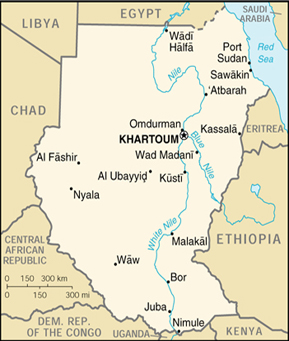The Jonglei Canal
The Egyptians' need for water has not diminished. In 1990 they supplemented their Nile allocation to a total of 65.3 BCM, and this number had increased to 69.4 BCM in 2000. They augment the Nile by using both groundwater and treated agricultural and industrial waste water.
Where can more water be found? Ironically, the waters of the White Nile in southern Sudan likely hold the key to the economies of both Egypt and the Sudan (see maps below).

Natural vegetation in Africa.
Dark green = tropical rain forest,
Blue = East Africa coastal forest,
Medium green = deciduous forest-woodland savanna,
Light green = brush-grass savanna,
Yellow = steppe,
Pink = semidesert,
Orange = desert,
Red = Mediterranean evergreen forest,
Brown = temperate grassland, and
Purple = montane forest-tundra.
Source: African Conservation Foundation - http://www.africanconservation.org/vegetationmap.html

Sudan. Source: EmbassyWorld.com - http://www.embassyworld.com/embassy/Sudan/sudan_map.htm
In southern Sudan, the flat topography has created a vast swamp known as the Sudd--a huge area where the White Nile meanders towards Malakal. The Sudd covers about 6,370 square miles in the dry winter months and roughly doubles in area during the summer rains. The White Nile gets stalled in the Sudd, and about 17 BCM of water is lost through evaporation and transpiration. The idea of digging a canal through the Sudd in order to speed flow of the water is a current political issue, but proposals for the Jonglei Canal, and other major Nile Basin projects, go back generations.

A modern bucketwheel canal trencher. Source: Kraemer & Co. Mfg., Inc.
The digging of the Jonglei Canal began in 1978. A famous (no kidding) excavating machine known as the "Bucketwheel" was brought in from Pakistan, where it had dug a 101-km canal between the Indus and Jhelum rivers. Sudanese hydrologist Yahia Abdel Magid refurbished the Bucketwheel and brought it to Sudan. It is the largest excavator in the world, weighing over 2,100 tons. It has 12 giant buckets (3 cubic meters each) hung on a circular wheel (12.5 meters in diameter) which dig earth, then dump it onto a transmission belt, which deposits it on the bank. At full speed, the Bucketwheel can excavate 2 km a week but requires (10,000 gallons) of gasoline per 24 hours.
The Jonglei Canal project was considered one of the most important integration projects between Egypt and Sudan. The project was designed to make full use of the Nile, promote human and economic development in isolated regions, and boost agricultural development in both countries. In 1983, work was suspended as a result of the Sudanese civil war, and a missile launched by an unknown source destroyed the Bucketwheel. As a result, only the northern 180 km of the 360-km planned manmade channel is completed. Worse yet, the completed portion of the Jonglei Canal is drying out and falling apart.
Despite the possible benefits of having more irrigated farmland, the canal could have a devastating effect on the swampland environment and the people who live there. For example, draining water from the Sudd would reduce the swamp area by an estimated 36%, reducing the mosquito habitat (good), but also reducing the wetlands appropriate for grazing and wildlife habitat. Roughly two million people live in the area, and their livelihoods would be altered. Today they are dominantly semi-nomadic and move homes and livestock throughout the year. Land that has been under water for more than 20 years could be reclaimed, providing ideal ground for breeding cattle, while the canal itself would have provided new opportunities for fishing.
If peace is restored in the south of Sudan, a number of the obstacles that had previously hindered the project would no longer exist. The energy problem has been solved by the discovery of oil in the Bentiu region, which would allow for the establishment of a refinery to meet the needs of the southern territory and provide a cheap source of energy for drilling machines. Furthermore, with a large number of the region's youth having gained experience in the construction industry in the north--having fled to escape the war and find work--there should be no shortage of suitable labor.
What do YOU think? The Future of the Jonglei Canal
Think about the long-term impact on humans and the environment... should the Jonglei Canal project be completed? Explain why/why not from the human and environmental perspective. Post your thoughts and opinions to the Lesson 06 Discussion Forum (That discussion forum can be accessed at any time by clicking on the Communicate tab in ANGEL and then looking in the Discussion Forums box.)